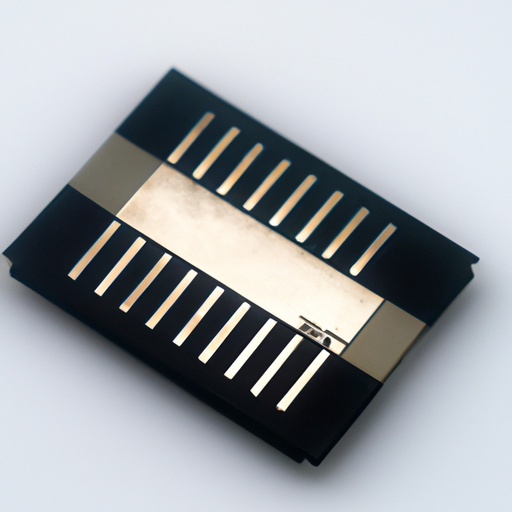Core Functional Technology of Through-Hole Resistors
1. Basic Functionality: Through-hole resistors are passive components that limit current flow in electronic circuits. They are essential for controlling voltage levels, dividing voltages, and providing biasing in various applications. Their resistance values, measured in ohms (Ω), dictate how much current can flow through them according to Ohm's Law (V = IR).

2. Construction: These resistors are typically cylindrical with two leads that are inserted into holes on a printed circuit board (PCB) and soldered in place. This through-hole design provides mechanical stability, making them suitable for prototyping, educational projects, and low-volume production runs.
| 3. Types of Resistors | Through-hole resistors come in several types, each suited for different applications: |
4. Power Rating: Through-hole resistors are available in various power ratings, typically ranging from 1/8W to several watts. This allows designers to select resistors that can handle the expected current without exceeding their thermal limits.
5. Tolerance: Resistors come with different tolerance levels, indicating the permissible variation from the stated resistance value. Common tolerances include ±1%, ±5%, and ±10%, which are crucial for applications requiring precise resistance values.
Application Development Cases
1. Signal Conditioning: In digital circuits utilizing the MM74HC4049N hex inverter, through-hole resistors can be employed to create voltage dividers or pull-up/pull-down configurations. For instance, when interfacing a sensor output with the inverter, resistors can condition the signal to ensure it meets the required logic levels, enhancing reliability in digital communication.
2. LED Drivers: When using the MM74HC4049N to drive LEDs, through-hole resistors are critical for current limiting. By calculating the appropriate resistor value using Ohm's Law, designers can ensure that the LED operates within its safe current range, preventing damage and ensuring longevity.
3. Oscillator Circuits: Through-hole resistors can be integrated with capacitors to form RC timing circuits. For example, in designing an oscillator circuit with the MM74HC4049N, resistors can determine the frequency of oscillation by controlling the charge and discharge times of the capacitors, allowing for precise timing applications.
4. Level Shifting: In mixed-voltage systems, through-hole resistors can facilitate level shifting. For instance, if the MM74HC4049N is interfacing with a 5V logic level and a 3.3V device, resistors can help adjust the voltage levels appropriately, ensuring compatibility between different logic families.
5. Feedback Networks: In applications where the MM74HC4049N is used in feedback loops (such as in amplifiers or oscillators), through-hole resistors can be utilized to set gain or stability parameters. This ensures that the circuit operates as intended, providing the desired performance characteristics.
Conclusion
Through-hole resistors are integral components in electronic design, particularly when used in conjunction with devices like the MM74HC4049N hex inverter. Their robust construction, ease of use, and versatility make them ideal for prototyping and low-volume production. Understanding their functionality and applications can significantly enhance circuit design, performance, and reliability in various electronic projects.
Core Functional Technology of Through-Hole Resistors
1. Basic Functionality: Through-hole resistors are passive components that limit current flow in electronic circuits. They are essential for controlling voltage levels, dividing voltages, and providing biasing in various applications. Their resistance values, measured in ohms (Ω), dictate how much current can flow through them according to Ohm's Law (V = IR).

2. Construction: These resistors are typically cylindrical with two leads that are inserted into holes on a printed circuit board (PCB) and soldered in place. This through-hole design provides mechanical stability, making them suitable for prototyping, educational projects, and low-volume production runs.
| 3. Types of Resistors | Through-hole resistors come in several types, each suited for different applications: |
4. Power Rating: Through-hole resistors are available in various power ratings, typically ranging from 1/8W to several watts. This allows designers to select resistors that can handle the expected current without exceeding their thermal limits.
5. Tolerance: Resistors come with different tolerance levels, indicating the permissible variation from the stated resistance value. Common tolerances include ±1%, ±5%, and ±10%, which are crucial for applications requiring precise resistance values.
Application Development Cases
1. Signal Conditioning: In digital circuits utilizing the MM74HC4049N hex inverter, through-hole resistors can be employed to create voltage dividers or pull-up/pull-down configurations. For instance, when interfacing a sensor output with the inverter, resistors can condition the signal to ensure it meets the required logic levels, enhancing reliability in digital communication.
2. LED Drivers: When using the MM74HC4049N to drive LEDs, through-hole resistors are critical for current limiting. By calculating the appropriate resistor value using Ohm's Law, designers can ensure that the LED operates within its safe current range, preventing damage and ensuring longevity.
3. Oscillator Circuits: Through-hole resistors can be integrated with capacitors to form RC timing circuits. For example, in designing an oscillator circuit with the MM74HC4049N, resistors can determine the frequency of oscillation by controlling the charge and discharge times of the capacitors, allowing for precise timing applications.
4. Level Shifting: In mixed-voltage systems, through-hole resistors can facilitate level shifting. For instance, if the MM74HC4049N is interfacing with a 5V logic level and a 3.3V device, resistors can help adjust the voltage levels appropriately, ensuring compatibility between different logic families.
5. Feedback Networks: In applications where the MM74HC4049N is used in feedback loops (such as in amplifiers or oscillators), through-hole resistors can be utilized to set gain or stability parameters. This ensures that the circuit operates as intended, providing the desired performance characteristics.
Conclusion
Through-hole resistors are integral components in electronic design, particularly when used in conjunction with devices like the MM74HC4049N hex inverter. Their robust construction, ease of use, and versatility make them ideal for prototyping and low-volume production. Understanding their functionality and applications can significantly enhance circuit design, performance, and reliability in various electronic projects.






